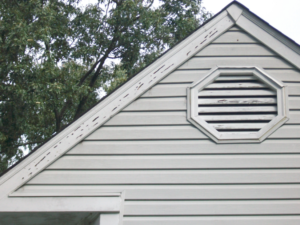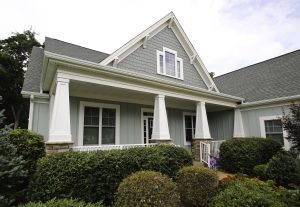HAVE YOU EVER WALKED AROUND YOUR HOUSE AND NOTICED THIS?

If you have ever wondered what those holes were from, then please read this article. As a licensed contractor, I am around thousands of houses each year and I see this frequently. Many homeowners do not know where, what or how this happens. The answer is simple, the left side rake board has been eaten by carpenter bees. Entomology.com gives a great description of what many homeowners face each year ” In the late-spring and early summer, homeowners often notice large, black bees hovering around the outside of their homes. These are probably carpenter bees searching for mates and favorable sites to construct their nests. Male carpenter bees are quite aggressive, often hovering in front of people who are around the nests. The males are quite harmless, however, since they lack stingers. Female carpenter bees can inflict a painful sting but seldom will unless they are handled or molested.” What is most interesting is the carpenter bees will leave a perfect cylindrical hole in the wood, but then the wood peckers come looking for the larva and they are the ones who do the most destruction causing the holes to enlarge to the left and right. The first step is to identify the holes and understand your options:
- Patch, Sand and Paint
- Replace with wood
- Replace with PVC (Highly Recommended)
OPTION 1:
The first option is the quickest and easiest, but it may not last long. You can use a wood filler or an automotive bondo to fill the hole. Let it dry, sand, spot prime and paint the board when ready. The bees can move to another spot on the wood or even break through your filler and you can be back to where you started and that is why we do not recommend this option.
OPTION 2:
The next option is to replace with wood. The benefit to replacing with wood is you do not have to patch, sand and paint those holes, which can leave an uneven appearance. If you have the right tools and knowledge, replacing with wood can easily be done and the usual 1×6 or 1×8 wood material are very inexpensive. The biggest con to replacing with wood is after the project is complete, the carpenter bees can come right back to your brand new wood. That is why we recommend choosing option 3.
OPTION 3:
Our favorite and most common choice is to replace the entire board with PVC. The PVC is so strong that the carpenter bees cannot bore through the newly installed materials. This is why this is the best option. The upfront PVC material cost is the only drawback when choosing this method, but knowing once it is installed you will not have to worry about it is well worth it.
If you have any questions or want to learn more about protecting your home, please call Brian Martin at 757-310-2926.



